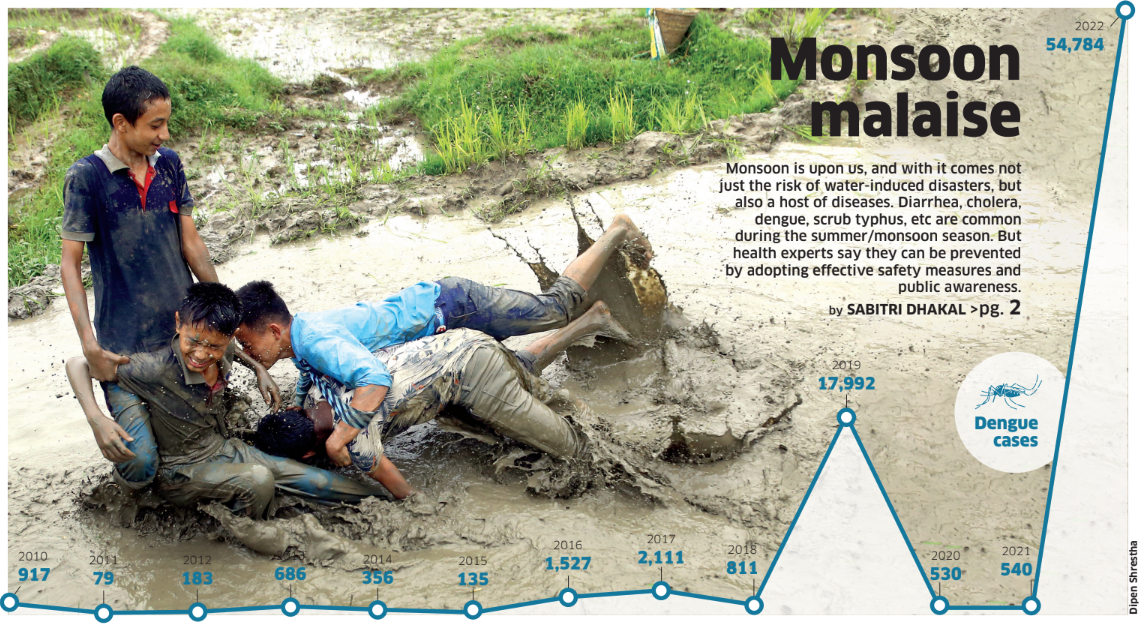Monsoon rains provide a perfect breeding ground for bacteria and viruses. Therefore, with the onset of the monsoon there is always a risk for a rise of infectious diseases. If the public is unaware, the risk for the outbreak of the infectious diseases will take a toll on the lives of people. There are chances of vector- and water-borne diseases appearing during the monsoon season, but they can be prevented through protective measures and community mobilization, health experts say. Diarrheal diseases With the rainfall water sources get polluted and as a result a large number of people could suffer from diarrheal diseases. There is a risk of diarrhea, dysentery, cholera, and salmonellosis breaking out during the rainy season. Such outbreaks are usually caused by polluted water resources. Flooding sweeps decayed particles, dead animal carcasses, sewage and several other pollutants with them polluting clean water. “Consumption of such water and food washed and prepared using such polluted water causes diarrheal diseases,” says Dr Sher Bahadur Pun, chief of the Clinical Research Unit at Sukraraj Tropical and Infectious Disease Hospital. Last year as of 5 Sept, a total of 76 cases of cholera were reported in Kathmandu, Lalitpur, Nuwakot and Dhading districts. Case investigation revealed that the cause of the cholera outbreak was use of tap water for drinking purposes and use of commercial drinking water. Four samples of stored tap, jar and ground water from the index case household and workplace were found to be contaminated with coliform, according to the Epidemiology and Disease Control Division. Besides diarrheal diseases, health experts warn people are also likely to suffer from Hepatitis A and E during the monsoons, as the viruses can transmit to humans through contaminated water. Vector-borne diseases According to the World Health Organization, vector-borne diseases account for more than 17 percent of all infectious diseases, causing more than 700,000 deaths annually. They can be caused by either parasites, bacteria or viruses. Every year hundreds of people are infected by diseases such as malaria, dengue, chagas disease, Japanese encephalitis, the WHO says. Mosquitoes are common during summer. As stagnant water is necessary for mosquitoes to breed, monsoon creates a favorable environment for mosquitoes to breed. “Rainwater gets collected in flowerpots, pots, tires of vehicles and puddles, where mosquitoes lay their eggs. This is why there are high chances of dengue during the monsoon season,” says Dr Gokarna Dahal, chief of vector borne disease control section, EDCD. Transmitted from the Aedes Aegypti mosquito, the symptoms of dengue range from mild fever to high grade fever, headache and pain behind the eyes. It also includes muscle and joint pain, and skin rashes. In Nepal, dengue is a rapidly emerging disease. Endemic across most provinces, dengue incidence has increased in recent years, largely due to expansion of the vector Aedes aegypti and Aedes albopictus, as well as the movement of people and the introduction of imported cases, the EDCD says. The disease is quite common in Tarai region in the country. A total of 54,784 dengue cases were identified from across the country last year; 88 dengue-related deaths were reported. According to the WHO, there is no specific treatment for dengue/severe dengue, but early detection and access to proper medical care lowers fatality rates below one percent. In Nepal, monsoon season occurs during June—August. The dengue season closely follows this period with cases occurring between September and November. Given the presence of a largely susceptible human population, human movement, the presence of both Aedes vectors and all four dengue serotypes, this trend is unlikely to reverse over the coming decades. Indeed, the burden may continue to increase, likely resulting in an increasing number of severe dengue cases, particularly in and around Kathmandu, as per the EDCD. The highest numbers of cases were reported from Kathmandu (14375), Lalitpur (9614), Bhaktapur (6145), Makawanpur (5837), Chitwan (3213), Dang (2428), Dhading (1683) and Rupandehi (1215). The mosquitoes that spread dengue are active during the day. Change in the season also increases the risk of viral influenza. Health experts advise seeking medical attention in case of persistent and severe flu-like symptoms. Scrub typhus is another disease that the public need to be aware of during the monsoon season. Also known as bush typhus, Scrub typhus is an acute, febrile, infectious disease caused by Orientia tsutsugamushi. It is spread to people through bites of infected chiggers (larval mites). The most common symptoms of scrub typhus include fever, headache, body aches, and sometimes rash. Most cases of scrub typhus occur in rural areas. This is an infectious bacterial disease caused by Leptospira—bacteria found in rodents. “Whenever there is flooding, these bacteria get mixed with water and enter the human body through cuts in feet. Those working in fields are prone to the disease as they work bare feet. So, people working in fields and villages need to be aware about the disease,” says Dr Pun. Besides vector-borne diseases, snakebite cases also go up during the summer/monsoon period. In the fiscal year 2021/22, some 8,000 people came for treatment of snakebites at government health facilities around the country, according to the Ministry of Health and Population. Seven in eight of these cases involved non-venomous bites, its data showed. Only about 1,000 patients actually needed anti-venom treatment, according to the data. Of them, 100 snakebite patients lost their lives—either because they reached hospital too late or because they could not get the right treatment. To prevent snake bites
- Never play with snakes, or irritate them. Do not provoke them
- Use a torch light if you have to walk in the dark
- Keep the household clean: cut grasses and bushes, fill holes, and close doors and windows properly
- Use a stick and hit on the earth surface when walking in the dark. Snake will move away because of its vibration
- Control rodents to prevent snake bites
- Avoid sleeping on the floor. If it is unavoidable, use a mosquito net and tuck it well
- Check shoes and clothes before wearing if you are in areas where snakes are abundant
- Wear shoes
To prevent mosquito bites
- Clothes that cover as much of your body as possible
- Mosquito nets if sleeping during the day
- Window screens
- Mosquito repellents
- Coils and vaporizers
To prevent the dengue and malaria
- Search and destroy mosquitoes and their breeding areas
- Keep environment clean
- Use nets and apply mosquito repellents
- Wear long sleeves and pants to cover arms and legs
- Remove water from flower/plant pots and plates
- Change water in vases/bowls
- Remove water from tyres
- Take medicines only on doctor’s advice











